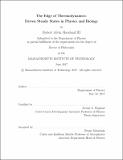The edge of thermodynamics : driven steady states in physics and biology
Author(s)
Marsland, Robert Alvin, III
DownloadFull printable version (6.061Mb)
Other Contributors
Massachusetts Institute of Technology. Department of Physics.
Advisor
Jeremy L. England.
Terms of use
Metadata
Show full item recordAbstract
From its inception, statistical mechanics has aspired to become the link between biology and physics. But classical statistical mechanics dealt primarily with systems in thermal equilibrium, where detailed balance forbids the directed motion characteristic of living things. Formal variational principles have recently been discovered for nonequilibrium systems that characterize their steady-state properties in terms of generalized thermodynamic quantities. Concrete computations using these principles can usually only be carried out in certain limiting regimes, including the near-equilibrium regime of linear response theory. But the general results provide a solid starting point for defining these regimes, demarcating the extent to which system's behavior can be understood in thermodynamic terms. I use these new results to determine the range of validity of a variational procedure for predicting the properties of near-equilibrium steady states, illustrating my conclusions with a simulation of a sheared Brownian colloid. The variational principle provides a good prediction of the average shear stress at arbitrarily high shear rates, correctly capturing the phenomenon of shear thinning. I then present the findings of an experimental collaboration, involving a specific example of a nonequilibrium structure used by living cells in the process of endocytosis. I first describe the mathematical model I developed to infer concentrations of signaling molecules that control the state of this structure from existing microscopy data. Then I show how I performed the inference, with special attention to the quantification of uncertainty, accounting for the possibility of "sloppy modes" in the high-dimensional parameter space. In the final chapter I identify a trade-off between the strength of this kind of structure and its speed of recovery from perturbations, and show how nonequilibrium driving forces can accelerate the dynamics without sacrificing mechanical integrity.
Description
Thesis: Ph. D., Massachusetts Institute of Technology, Department of Physics, 2017. This electronic version was submitted by the student author. The certified thesis is available in the Institute Archives and Special Collections. Cataloged from student-submitted PDF version of thesis. Includes bibliographical references (pages 135-141).
Date issued
2017Department
Massachusetts Institute of Technology. Department of PhysicsPublisher
Massachusetts Institute of Technology
Keywords
Physics.